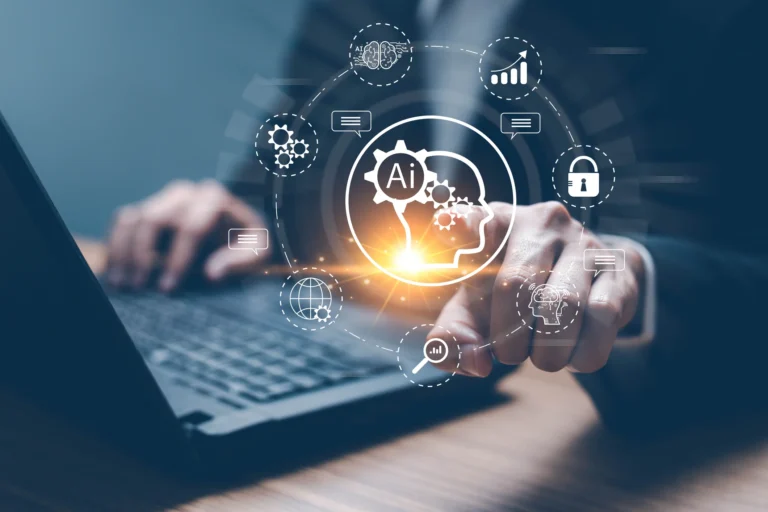
This article will encourage you to use AI in your marketing. Take a look at some of the stats that praise AI.
- Amazon uses AI for predicting customer needs, and then presents products that meet those needs. This results in 35% of all sales.
- Warby Parker uses AI to create highly curated customer experiences and guide users towards specific results.
- Netflix uses AI to customize recommendations and drive 80% of total watchtime on the platform.
It’s hard to know where to start. These statistics show AI marketing can have a huge impact on marketing results. We’re here for you.
Table of Contents
What is AI Marketing?
AI marketing is a combination of machine learning and reinforcement learning powered by customer data, that helps businesses reach their marketing goals.
AI automates tasks that were previously done manually and scales up operations. This allows teams to grow without having to add more staff.
Three goals are at the core of every marketing department: acquiring new customers, retaining existing ones, and educating them. It is not easy to achieve these goals. The majority of companies are aware of the steps to take to reach their goals, but it is difficult to scale and resource-intensive to do so. AI marketing can help you take the necessary steps to achieve your goal. AI marketing will handle these tedious tasks and allow you to concentrate on more important decisions, such as creating new campaigns or identifying untapped opportunities that produce significant results.
AI’s impact on business is indisputable. The BBC reported that it could replace 300 million jobs. For marketers, the focus is not on replacing jobs, but rather on results. Marketing teams that are successful focus on their North Star metric. This could be a streaming service looking to increase engagement, or a retailer trying to drive adoption of their mobile app. This means that for most companies, it is about increasing the customer lifetime value.
Teams can reduce costs, increase revenue, and gain a competitive advantage by incorporating AI in their marketing efforts. AI is a powerful tool that allows marketers to achieve measurable results while maintaining service quality and passing savings to their customers.
How to develop an AI marketing strategy
Your AI marketing strategy must combine AI Decisioning and generative AI. In 2022, the rise of generative AI, led by ChatGPT and other tools, revolutionized creative thinking. Large language models (LLMs), which are used by marketers to create ad copy and images, as well as video scripts, were developed. AI is capable of more than just generating text, images, or videos. It can also help produce tangible results. AI Decisioning is a powerful tool that allows AI agents to make intelligent choices. This is why marketing teams need both types of AI. Data is the foundation of every effective AI marketing strategy. The more data that you collect, the more quickly and accurately you can train and build AI models.
You need to determine your north star metric to be able to set up AI effectively to optimize this outcome. Netflix’s north-star metric could be the amount of time spent watching, while Amazon’s might be the lifetime value of customers. It’s important to keep track of your north star as it changes over time.
AI will handle most of the decisions, so you can focus more on your campaign strategy – writing copy, choosing images, and selecting channels. AI can run experiments on a larger scale than humans are capable of, then take the learnings back and share them with your marketing team. AI continually tests and refines creative elements in response to customer behavior, revealing which combinations resonate the best. You can add new variables over time, such as different images or messages, while AI is learning from the audience’s behavior. This ensures that each touchpoint will be optimized for both creative impact and customer behaviour.
Below, we’ll explain some specific tools and use cases that you can use to leverage AI in your marketing.
AI in Email Marketing
Email marketing is a powerful, cost-effective channel that can be used by all marketers. Even small incremental changes in terms of open click-through rate can be hugely beneficial. Testing and optimizing thousands s different emails, subject lines, creatives, and CTAs takes too much time and is not scalable.
You can use AI to continuously experiment with subject lines, body text, CTA, and the time of day for your emails, so that you achieve your desired results, such as an increased clickthrough or open rate. You can create journeys and enroll users based on their actions or engagement levels. This will ensure that they are always on the right journey for your desired outcome.
How AI can transform email marketing
- AI can identify the subject lines that are most likely to engage customers by analysing historical data and trends for similar audiences. AI could, for example, discover that emojis can increase open rates in younger audiences while formal language resonates better with older demographics. It could suggest that a user’s subject line be “Don’t Miss Out on Your Exclusive Offer!” instead of “Exclusive Deal Inside.”
- AI can increase click-through rates by tailoring email content, such as tone, copy, and offers, to individual customer preferences. This could potentially increase the likelihood of engagement. AI could, for example, notice that customers from colder climates respond better to winter gear promotions. In this scenario, an email might highlight a special offer on coats, while customers in warmer climates may receive emails highlighting sunscreen or summer clothing.
You can use these tools to implement AI into your email marketing.
- Hightouch AI decisioning is an AI agent that helps you with your campaigns. You set your goals, and then provide content (e.g, subject lines, offers), customer data, and various content. Hightouch AI determines which combinations and timings are most effective in reaching customers and leading them towards your desired outcome. AI Decisioning is not just limited to emails, but can help you choose the best channel.
- ActiveCampaign uses AI to generate subject lines, copy, and calls to action. The platform can also be used to create AI-driven email journeys that are static for increased engagement.
- MailChimp has AI features that optimize email design, predict segmentation of audiences, and generate alt texts for images. This ensures accessibility and better customer targeting.
- Klaviyo Email AI refines email content, generating copy and suggesting layouts. It also recommends images, products, and button designs, resulting in more effective campaigns.
Artificial Intelligence in Content Marketing
Content marketing can help you build credibility and authority, as well as organic traffic for your website. Content marketers will see more sales opportunities if they can increase traffic and convert visitors. The majority of content teams know what works and doesn’t work. Most content teams have limited resources and are prone to getting bogged down with tasks that do not move the needle.
AI can automate many aspects of the content marketing process, such as keyword research for SEO, programmatic SEO, and customer research. This ensures that every piece is relevant and accurate.
Content marketing can be transformed by AI.
- Boost your content appeal: You could use AI to create media, such as videos and images, to enhance your content and engage readers for longer. A software company, for example, might use AI in order to create a video that showcases its latest features, which would make complex technical concepts more understandable.
- Assure consistent distribution: Automate the scheduling of content and maintain distribution within a time frame so that content is distributed optimally on each channel, and then re-distributed in order to increase engagement. A marketing team, for example, can create blog posts and social media updates, then let AI post at the best time. They can also resurface these articles to increase engagement.
- Streamline your research: You can streamline research efforts by identifying topics that are trending and collecting relevant data to create content. A fashion brand, for example, could use AI to discover seasonal trends such as “eco-friendly winter wear” to guide content on their blog or campaign.
These tools leverage AI to optimize your content marketing efforts.
- Jasper can help you generate ideas for content and then turn them into articles with images. It helps create content strategies by identifying keywords that are of high value. Jasper automates repetitive tasks, such as writing meta descriptions and headlines.
- Grammarly is a powerful AI editor that seamlessly integrates into workflows. Grammarly offers advanced spelling and grammar checkers and improves content quality with suggestions for rewrites and tone adjustments that better suit your audience.
- Copy.ai is a leader in the creation of diverse content – from articles to social media posts and ad copy. Its AI agents are capable of performing repetitive tasks such as compiling the top Google search results to assist with content research and creation.
- WriteSonic is an AI-based writing assistant that can generate articles of up to 1,500 characters, create ad copy, and write product descriptions. Other features include AI image creation, text-to-speech conversion, and an SEO checker for optimizing content for search engines.
AI in Paid Media
Paid media can be very useful because they allow you to reach a new audience and also target certain people with your message. Advertising that can influence return on advertising spend (ROAS) and cost per acquisition will increase overall revenue and profitability. Many businesses, however, only try to personalize the customer experience superficially by grouping them into broad segments on the basis of generic factors such as behavior or persona. This results in impersonal, ineffective marketing that fails to resonate with customers and hinders conversions.
AI allows you to experiment with creatives for ads and target audiences, allowing you to find a successful campaign without a lot of manual work.
AI can be used to transform your paid-media strategy in many ways.
- AI can help you place ads more efficiently. AI allows for real-time buying and placing of ads, so your ads may reach the right audience when they are needed. AI can be used by an e-commerce company to bid for placements of ads that are relevant to users who have recently browsed products similar to those on the competitor’s website. This could help boost conversions.
- AI can help you convert more customers: AI can segment audiences and provide them with ads that are tailored to their tastes, leading to higher conversion rates and engagement. A fitness brand, for example, could use AI to segment audiences by activity level. They would then promote high-performance gear and comfortable activewear to casual exercisers.
- AI can automate repetitive processes like campaign creation, copywriting, and performance tracking, giving you the opportunity to spend more time on strategy. A SaaS firm, for example, could use an AI tool that would write headlines, choose relevant visuals, and launch a marketing campaign to promote a new feature. The AI tool could analyze click-through rate and make suggestions for improved engagement.
Here are some tools to help you integrate AI into paid media:
- Adcreative.ai generates compelling copy and visuals for your ads, gives you insights on why certain ads work, and analyzes competitor campaigns to find actionable strategies.
- Kokai is an AI platform from The Trade Desk that automates the media buying process by adjusting bids, refining strategies, and analyzing demographics, past purchases, and customer behaviors.
AI Personalization
For business success, it is crucial to personalize your customers’ experience. McKinsey claims that effective personalization reduces customer acquisition costs by up to 50%, and increases revenues by between 5 to 15%. The user’s journey is also enhanced by showing them content or products that they find interesting.
Many businesses, however, only try to personalize in a superficial way by dividing customers into broad segments on the basis of generic factors such as behavior or persona. This results in a lack of personalization and effectiveness, which ultimately hurts conversions.
AI can revolutionize this process through true personalization. It can help you get away from generic personalized content, which is not the best for anyone. AI instead uses an adaptive method that constantly learns and adapts to deliver content tailored for each individual, through the appropriate channel.
Here are some key ways AI can improve personalization:
- Cross-sells and upselling: By analyzing current and historic customer data, businesses can identify opportunities to increase average order values (AOVs) by recommending complementary items. D2C businesses, for example, use checkout flows to offer special offers such as discounted accessories and bundling options. These personalized recommendations can increase revenue and improve the customer experience. They can be delivered by email, website, or app.
- Win-back: Reengaging lapsed clients often requires analyzing behavioral data to craft tailored messages and offers. If a traveler has previously booked flights, but not recently, then a personalized promotion could be used to entice them back. This might include discounts on the destinations they most frequently search for or upgraded accommodations for their next vacation. You can re-engage customers by addressing their disengagement and presenting them with customized offers.
- Content personalized: The dynamic personalization of content ensures users are shown the most relevant content, whether it is on a website, an app, or in email campaigns. This strategy is applicable across industries to increase engagement and loyalty. Netflix, for example, might suggest new shows and movies based on a user’s viewing preferences and history. This creates a more personalized and enjoyable experience.
- Product recommendations: Using purchase histories and behavior data to generate relevant suggestions is the cornerstone of success in e-commerce. Amazon, for instance, is excellent at recommending products that are based on previous purchases, browsing habits, and trends among users. Businesses can increase sales and improve customer satisfaction by integrating recommendations into their website interactions, email campaigns, and ad-targeting.
Consider these tools to implement AI-driven Personalization effectively:
- Hightouch AI Decisioning combines connections with your data warehouse to provide access to comprehensive data about customers to power personalized experiences at all touchpoints – from in-app campaigns to email campaigns. Its AI decisioning agent constantly learns and adapts to customer-specific strategies, optimizing marketing outcomes.
- Mutiny creates websites that adapt dynamically to visitors. By analyzing visitor data, website components are personalized in real-time to cater to the experience for each unique user.
Video marketing with AI
The success of video marketing is measured by many metrics. However, the key indicators such as engagement (watching time) and CTR (click-through rate) are dependent on both high-quality content (and strategic execution) and quality content. These metrics are often overlooked by marketers due to manual and time-consuming editing tasks. AI can automate video editing and free up time for you to create new content or refine your successful strategies.
AI in video marketing can help with:
- Editing Content: AI tools can be used to streamline video editing, automating tasks such as removing filler text, assembling clips based upon specific criteria, like pace or storytelling, improving video quality with color grading, and reducing noise. AI tools can be used by businesses to edit customer testimonials quickly, for example, by removing pauses and stutters. This will ensure a polished product that is suitable for use in social media campaigns or advertising.
- Automating captions and transcripts: AI analyzes the audio content in your video to generate accurate captions or transcripts, increasing accessibility and engagement. A company that produces tutorial videos, for example, can automatically generate captions to make the content more accessible to viewers, such as those with hearing impairments and non-native English speakers.
- Generative AI can create stock footage or B-roll, making your video more dynamic and appealing. Marketing teams can generate background footage, like animated cityscapes and abstract visuals for product launch videos, without having to rely on expensive stock libraries.
- AI avatars can be created by providing a script. AI will then generate realistic avatars in which the script is read and performed in multiple languages. AI avatars can be used by businesses to create personalized greetings or multilingual videos for clients.
Here are some tools that will help you to integrate AI into video marketing.
- Synthesia transforms text into video using AI avatars. It supports over 120 accents and languages, allowing you to create personalized content tailored to the native language of your audience.
- Runway creates video content unique to your project that you can integrate seamlessly by providing a prompt.
- Veed.io is a video editing software powered by AI. Features include audio enhancements, automatic removal of filler words, and eye contact correction.
AI in Marketing Automation
Many marketing processes are manual and repetitive. This could include moving data, creating and sending messages, or conducting research. These tasks take up valuable time, which could be used for higher-level initiatives. Automation is, therefore, a better option than human effort.
AI can handle tasks such as sending out outreach emails or creating customer journeys and email flows. AI is more than just automation. It continuously refines and learns from these processes to improve efficiency.
AI in marketing automation helps you:
- AI can be used to personalize customer onboarding by tailoring flows based on the interactions of each person. An AI system could, for example, analyze the recent product searches of a customer and recommend an onboarding flow that highlights those features. AI can increase the likelihood of engagement and activation by delivering content aligned with specific needs.
- Journey orchestration: Marketers are able to use AI in order to design unique customer journeys that increase engagement and help achieve marketing goals. This journey orchestration is possible across channels and content. An AI tool could, for example, monitor the user’s behavior in an app to change the sequence of notifications, or suggest tutorials that are relevant, and ensure the customer is engaged.
- Sales outbound: Effective sales outbound requires extensive research and personalization–tasks perfectly suited for AI. An AI agent could, for example, identify a company that frequently visits your pricing page. After analyzing their industry trends and identifying potential pain points such as customer retention or scaling issues, an AI agent creates a customized email that explains how your solution can address these needs. The agent will then make sure that the email is delivered at just the right time to maximize engagement.
Here are some tools to help you with AI marketing automation.
- Hightouch AI Decisioning uses machine learning and reinforcement to create personalized experiences for customers, increasing engagement, revenue, and lifetime value.
- UnifyGTM automates outbound sales tasks that are repetitive, identifies the ideal buyer, and uses AI agents to run outreach on autopilot.
Closing Thoughts
The technology industry is experiencing a Cambrian boom as big tech companies race to dominate the AI market, and businesses are implementing it. AI is not going to replace marketers. AI-powered marketing will not replace marketers.
Many marketers still have concerns about AI, mainly because most platforms are black boxes that do not allow them to see how decisions are made. It is important to keep this in mind as you use AI to solve your specific problems.
In the age of AI, the most important things to differentiate yourself will be your frameworks and original thoughts. Do not fall in love because the technology today will not be the technology tomorrow. You will never be able to change the problems if you fall in love with them. People used to look at newspapers in order to avoid boredom. Now they stare at their smartphones.
Book a High touch AI Decisioning demo with our solution engineers if you are interested in implementing AI within your organization. This will allow you to scale your desired outcomes and understand the decisions being made.






